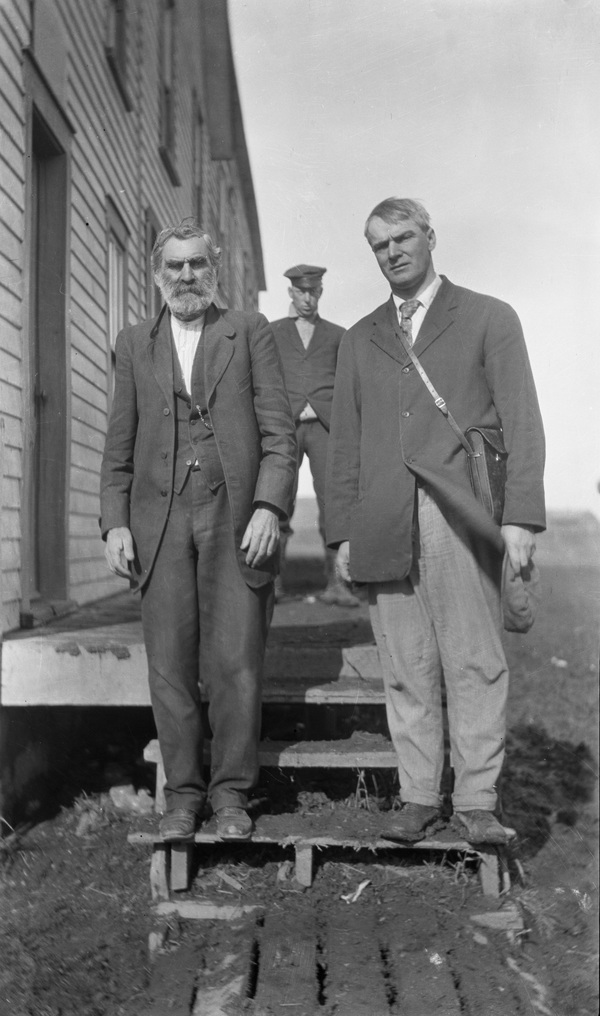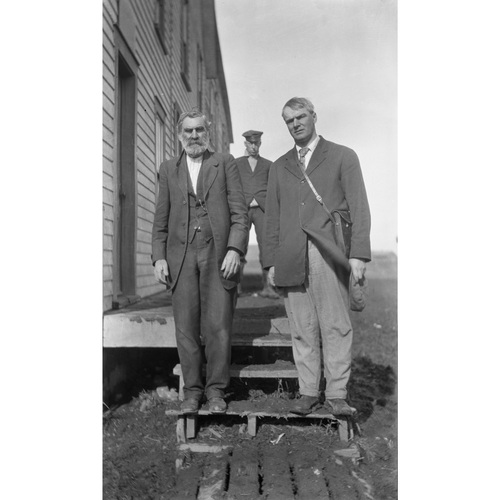
Source: Link
LÉGARÉ, JEAN-LOUIS, businessman, office holder, and rancher; b. 25 Oct. 1841 in Saint-Jacques-de-l’Achigan (Saint-Jacques), Lower Canada, son of François-Xavier Légaré and Julie Melançon; m. 15 or 22 April 1873 Marie Ouellette (d. 1876) at the mission of St Florent (Lebret, Sask.), and they had one son; d. 1 Feb. 1918 in Willow Bunch, Sask.
In 1866, at age 25, Jean-Louis Légaré left rural Lower Canada in search of work and adventure. His travels took him first to the eastern United States and then west to Minnesota, where he held various labouring jobs. Afterwards, he journeyed farther west to Pembina and Devils Lake (N.Dak.) and there worked as a clerk and freighter for Métis traders. In 1871 he opened a trading post at Wood Mountain (Sask.), and two years later he married the daughter of a prominent Métis merchant. After a marriage feast that lasted two days, the couple travelled in decorated dog-sleds from the Qu’Appelle valley to their home in Wood Mountain.
The rhythm of Légaré’s life was suddenly interrupted in the winter of 1876 by the arrival in the Wood Mountain area of large numbers of Sioux (or, more correctly, Dakota) under Sitting Bull [Ta-tanka I-yotank*] who were seeking refuge following the rout of Lieutenant-Colonel George Armstrong Custer’s cavalry unit at Little Bighorn River (Mont.). The first encounter between Légaré and the Sioux occurred when a small band of natives entered his post and declared that they had come to trade. Légaré and his five Métis employees were obliging to this group, and the following day 70 lodges were established in the vicinity. By the following spring, it has been estimated, there were as many as 4,000 Sioux at Wood Mountain.
During the next four years the exiles were to be a major concern of the North-West Mounted Police, who, under Superintendent James Morrow Walsh*, re-established the Wood Mountain post they had abandoned in 1875. Légaré himself initially prospered because of the newcomers, supplying them with provisions in exchange for buffalo robes, but they soon became a drain on his resources. With the disappearance of the buffalo herds from the area, the refugees had little to trade and, increasingly destitute, they were forced to ask Légaré for provisions as gifts. The trader participated in American and Canadian efforts to persuade them to return to the United States, even sponsoring a feast in 1878 at his own expense. All such efforts failed, however, and Légaré’s problems worsened in 1880 when, as a result of a destructive prairie fire, most of the Wood Mountain Métis moved, some going south and others relocating to a wintering site 45 miles southeast that they called Talle de Saules (Willow Bunch). Légaré decided to follow the latter group, building a home and establishing a store in the new settlement. Unfortunately for him, many of the Sioux relocated as well.
When another NWMP superintendent, Lief Newry Fitzroy Crozier*, failed in early 1881 to induce Sitting Bull and his followers to leave Canada, Légaré, with Crozier’s support, resolved to take action on his own. On two separate occasions, he persuaded groups to accompany him to Fort Buford (near Williston, N.Dak.), where, convinced of the Americans’ good intentions, they decided to remain. Sitting Bull himself was reluctant to return to the United States, but eventually he relented, joining a party of about 200 that left for Fort Buford in mid July. On entering the fort, Sitting Bull is reported to have said to the American officers: “I heard that the Government want me to return, Jean Louis told me so I took his word And Came Back With my friend.”
In persuading Sitting Bull to return to the United States, Légaré was motivated partly by concern for his livelihood and partly by compassion for the exiles. He expected fair recompense for his efforts from both the American and the Canadian governments, but he was to be disappointed in this regard. In August 1882 the Department of the Interior, after consultation with NWMP commissioner Acheson Gosford Irvine and Indian affairs commissioner Edgar Dewdney, awarded Légaré $2,000 in compensation; however, Légaré, who had kept a detailed record of his expenses, maintained that the amount he deserved was closer to $46,000. He had no greater success in the United States. In 1882 he charged the American government $13,412, but two successive bills to award him compensation, though passed by Congress, foundered in the Court of Claims. Finally, in 1905, the United States government paid Légaré $5,000. In this century the Légaré family has continued to lobby for compensation from the United States and Canada.
During his long struggle for financial redress, Légaré constantly emphasized to Canadian government officials that, in the event of trouble among native people in the west, he would “exercise a pacifying influence” over the Métis of Willow Bunch, “as he had done and endeavoured to do heretofore.” He lived up to his word during the events of 1885 [see Louis Riel*], when he offered his services to local government officials. Explaining that the Métis of Willow Bunch and Wood Mountain were “in a starving condition [and] that they wished to remain there, so as not to be implicated in any way with the rebellion, and that they would be glad of any employment,” he persuaded the authorities to accept his plan for a unit of Métis scouts. Légaré’s recruitment efforts were opposed by some Métis elders, such as Ambroise Ouellette, but won the support of the local priest. Eventually numbering about 40 men, Légaré’s unit, in conjunction with the NWMP, patrolled the area from Moose Mountain in the east to Old Wives Lake in the west from 15 April to the end of May. The police regarded its performance as satisfactory, since the Métis patrols “fulfilled the double purpose of finding work for ‘idle hands to do’ and having the country thoroughly watched.” After the fall of Batoche, however, the police, who found working with Légaré difficult, preferred to employ Métis scouts more securely under their own control.
In the 1880s Légaré started a cattle ranch, the first in the Willow Bunch area, but, after the harsh winter of 1892–93, he concentrated on horse ranching; before 1907, he maintained an average of 700 cattle and 1,000 horses. He tried his hand at business ventures, such as a short-lived cheese factory and the sale of buffalo bones, he obtained government contracts for the sale of provisions to the natives, and he dealt in Métis scrip.
Standing six feet four inches tall, with a “full black beard” and “a quiet and dignified” bearing, Légaré was an impressive figure of a man. Active in local affairs, he held the offices of justice of the peace, census enumerator, postmaster, school trustee, and councillor of the Société Saint-Jean-Baptiste. A devout Roman Catholic, he donated 80 acres to the parish of Saint-Ignace-des-Saules for a new church and rectory in 1906, and he assisted the local clergy in the settlement of French Canadians, who by the early 1900s had displaced the Métis as the majority group in Willow Bunch. Among the new arrivals were his two brothers and a sister.
Légaré saw himself as a leader in his community and was acknowledged as such by others, both in his own time and after. In 1960 the community of Willow Bunch established a regional park in his honour, and in 1970 the Historic Sites and Monuments Board of Canada erected a plaque commemorating his life.
A number of artefacts relating to Jean-Louis Légaré are preserved in the Willow Bunch Museum, Willow Bunch, Sask.
Arch. de la Soc. Hist. de Saint-Boniface, Man., Demandes de scrip des Métis des Territoires du Nord-Ouest, 1886, 1900–1; Reg. de Pembina, Dakota du Nord (copie). Brigham Young Univ. Library, Special Coll. Div., Arch. and mss Dept. (Provo, Utah), W. M. Camp coll., box 1, folder 14 (Légaré to Camp, 27 Oct. 1910). NA, RG 10, 3691, file 13893; RG 15, DII, 1, 281, file 49185; RG 18, 2185. National Arch. (Washington), RG 123 (records of the United States Court of Claims), J.-L. Légaré (mfm. in NA, MG 10, A3). Saskatchewan Arch. Board (Regina), R-2.1009 (Haultain and Robson [law firm]), file no.IV.15 (papers re scouts in Willow Bunch and Wood Mountain led by Légaré and A. R. McDonald, 11 May 1896) (mfm.); R-430.1 (Arsène Godin fonds, “in memoriam,” 4 févr. 1918); R-SHS 11 .B (Johnny Chartrand, “Souvenirs de la capitulation de Sitting Bull au gouvernement américain en 1881” (1944), and “Corr. avec le gouvernement américain pour une pension, Janvier–août 1945”); R-SHS 34.D(biog. information and corr. regarding J-L. Légaré, 1937–46) [including corr. and his 1886 petition for redress from the American government]. Can., Parl., Sessional papers, 1886, report of the commissioner of the North-West Mounted Police, 1885, app.D. R. B. Deane, Mounted police life in Canada: a record of thirty-one years’ service (London, 1916; repr. Toronto, 1973). Walter Hildebrandt and Brian Hubner, The Cypress Hills: the land and its people (Saskatoon, 1994). Barry Potyondi, In Palliser’s triangle: living in the grasslands, 1850–1930 (Saskatoon, 1995). Clovis Rondeau, La Montagne de Bois, 1870–1920, [2nd ed.], trans. Simone LeGal et al., bound with Adrien Chabot, Willow Bunch, 1920-1970, trans. [Irène Bonin, named] Sister Gabrielle-Madeleine (2v. in 1, [Willow Bunch], 1970). R. M. Utley, The lance and the shield: the life and times of Sitting Bull (New York, 1993). Wood Mountain Hist. Soc., They came to Wood Mountain ([rev. ed., Wood Mountain, Sask., 1980?]).
Cite This Article
Brian Hubner and Diane Paulette Payment, “LÉGARÉ, JEAN-LOUIS,” in Dictionary of Canadian Biography, vol. 14, University of Toronto/Université Laval, 2003–, accessed January 6, 2025, https://www.biographi.ca/en/bio/legare_jean_louis_14E.html.
The citation above shows the format for footnotes and endnotes according to the Chicago manual of style (16th edition). Information to be used in other citation formats:
| Permalink: | https://www.biographi.ca/en/bio/legare_jean_louis_14E.html |
| Author of Article: | Brian Hubner and Diane Paulette Payment |
| Title of Article: | LÉGARÉ, JEAN-LOUIS |
| Publication Name: | Dictionary of Canadian Biography, vol. 14 |
| Publisher: | University of Toronto/Université Laval |
| Year of publication: | 1998 |
| Year of revision: | 1998 |
| Access Date: | January 6, 2025 |



